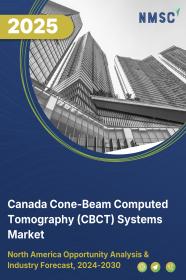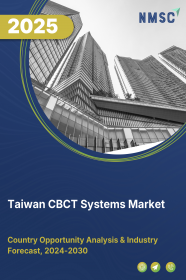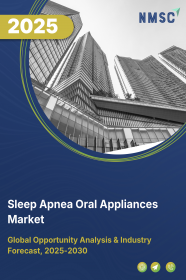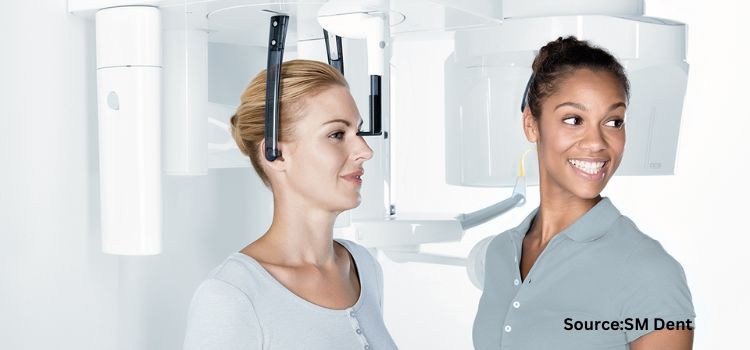
Canada Cone-Beam Computed Tomography (CBCT) Systems Market by Type (Floor Mounted and Wall Mounted), by Patient Position (Seated, Supine, and Standing), by Detector Type (Image Intensifier and Flat-Panel Detector), by Field of View (Small FOV Systems, Medium FOV Systems, and Large FOV Systems), by Application (Dental, ENT Applications, Orthopedic Conditions, and Others), and by End-Users (Dental Clinics, Hospitals, and Others)– Opportunity Analysis and Industry Forecast, 2025–2030
Industry: Healthcare | Publish Date: 14-Apr-2025 | No of Pages: 127 | No. of Tables: 93 | No. of Figures: 58 | Format: PDF | Report Code : HC808
US Tariff Impact on Canada Cone-Beam Computed Tomography (CBCT) Systems Market
Trump Tariffs Are Reshaping Global Business
Canada CBCT Systems Market Overview
Canada CBCT Systems Market size was valued at USD 53.8 million in 2024, and is predicted to reach USD 80.0 million by 2030, at a CAGR of 5.9% from 2025 to 2030. In terms of volume, the market size was 611 units in 2024, and is projected to reach 1041 units by 2030, with a CAGR of 8.4% from 2025 to 2030.
Several factors inclusive of growing aging population and government investment in clinical trials are driving the market growth. However, the extensive preference for economical imaging solutions such as regular 2D X-rays and dental panoramic radiograph poses a significant challenge to the CBCT market growth. On the contrary, integration of artificial intelligence (AI) in CBCT systems present lucrative opportunity for market expansion.
Moreover, top companies including Cefla Medical NA (Newtom), Acteon Group, Dentsply Sirona Inc., OSSTEM IMPLANT CO., LTD., DEXIS LLC and Hatch Group Inc., are actively developing new products and forming strategic collaborations to strengthen their market position.
Growing Aging Population Fuels the Canada CBCT Systems Market Growth
The rising elderly population in Canada is driving the market growth as medical professional increasingly implement advanced imaging technologies to diagnose and manage age-related conditions. Seniors commonly face health issue such as bone density loss, dental issues and chronic diseases making accurate imaging vital for proper treatment arrangements.
As per the latest report by the World Bank Group, Canadian’s citizens aged 65 and above increased from 15% in 2013 to 20% in 2023 reflecting a 53.8% growth over the past decade. This demographic shift is fueling the demand for CBCT technology as healthcare facilities seek advanced solutions to address the complex diagnostic needs of the elderly population.
Government Investment in Clinical Trials Drives the Market Demand
Government investment in clinical trials is a key driver for market growth that is strengthening research and development efforts in advanced imaging technologies. Increased funding enables healthcare institutions to assess the effectiveness and safety of CBCT across various medical specialties including dentistry, oncology and orthopedics.
According to the latest report by the Canadian Institutes of Health Research, more than USD 76.15 million is allocated to 36 clinical trials through the CIHR Clinical Trials Fund since 2022. This growing government support fosters innovation and accelerates the adoption of CBCT technology in clinical practice, meeting the rising demand for accurate diagnostic imaging solutions.
Alternate Cost-Effective Imaging Modalities Hinder the Canada CBCT Systems Market Expansion
The widespread preference for cost effective imaging technologies including traditional 2D X-rays and panoramic radiography poses a significant challenge to the growth of 3D dental scanners in Canada. These conventional methods remain the preferred choice for routine diagnostics due to the affordability among healthcare providers is limiting the adoption of CBCT technology in the country.
Integration of Artificial Intelligence (AI) in CBCT Systems Present Lucrative Opportunity for Market Expansion
The introduction of artificial intelligence (AI) in CBCT systems is anticipated to produce significant opportunities for market growth by improving diagnostic accuracy. AI algorithms streamline the analysis of imaging data allowing for quicker identification of deformity and alleviating the workload of health professionals which overall improves patient outcomes and heightens the adoption rates.
Additionally, the use of machine learning for image optimization and predictive analysis is expected to simplify the workflows reducing the need for manual intervention and enhancing the overall effectiveness of CBCT imaging across different healthcare applications.
Competitive Landscape
The promising key players operating in the Canada CBCT systems industry includes Cefla Medical NA (Newtom), Acteon Group, Dentsply Sirona Inc., OSSTEM IMPLANT CO., LTD. DEXIS LLC, Hatch Group Inc., Air Techniques, Carestream Dental, Kavo Dental, Planmed Oy and others.
Canada CBCT Systems Market Key Segments
By Type
-
Floor Mounted
-
Wall Mounted
By Patient Position
-
Seated
-
Supine
-
Standing
By Detector Type
-
Image Intensifier
-
Flat-Panel Detector
By Field of View
-
Small FOV Systems
-
Medium FOV Systems
-
Large FOV Systems
By Applications
-
Dental
-
Oral and Maxillofacial surgery (OMFS)
-
Endodontics
-
Implant Dentistry
-
Orthodontics
-
General Dentistry
-
Temporomandibular Joint (TMJ)
-
Periodontics
-
Forensic Dentistry
-
-
ENT Applications
-
Orthopedic Conditions
-
Neural and Spine
-
Veterinary
-
Other Application
By End-Users
-
Dental Clinics
-
Hospitals
-
Other End-User
Key Players
-
Cefla Medical NA (Newtom)
-
Acteon Group
-
Dentsply Sirona Inc.
-
OSSTEM IMPLANT CO. LTD.,
-
DEXIS LLC
-
Hatch Group Inc.
-
Air Techniques
-
Carestream Dental
-
Kavo Dental
-
Planmed Oy
REPORT SCOPE AND SEGMENTATION:
|
Paraments |
Details |
|
Market Size Value in 2024 |
USD 53.8 million |
|
Revenue Forecast in 2030 |
USD 80.0 million |
|
Value Growth Rate |
CAGR of 5.9% from 2025 to 2030 |
|
Market Volume in 2024 |
611 Units |
|
Market Forecast in 2030 |
1041 Units |
|
Volume Growth Rate |
CAGR of 8.4% from 2025 to 2030 |
|
Analysis Period |
2024–2030 |
|
Base Year Considered |
2024 |
|
Forecast Period |
2025–2030 |
|
Market Size Estimation |
Million (USD) |
|
Growth Factors |
|
|
Companies Profiled |
10 |
|
Market Share |
Available for 10 companies |
|
Customization Scope |
Free customization (equivalent up to 80 working hours of analysts) after purchase. Addition or alteration to country, regional, and segment scope. |
|
Pricing and Purchase Options |
Avail customized purchase options to meet your exact research needs. |

















 Speak to Our Analyst
Speak to Our Analyst





















